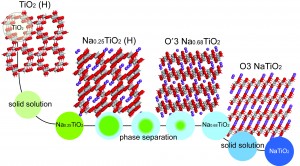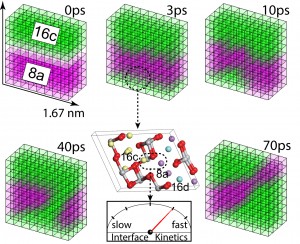First principle DFT calculations are used to study the thermodynamic and kinetic properties of Na-ion insertion in TiO2 hollandite, a potential anode for Na-ion batteries. The experimentally observed phase transformation from tetragonal TiO2 (I4/m) to monoclinic Na0.25TiO2 (I2/m) is confirmed. At high Na-ion concentrations the calculated formation energies predict a first order phase transition towards …
Category: Density Functional Theory
Using density functional theory (DFT) many material properties can be calculated. For example the voltage, diffusion rate, stability, phonon spectrum, etc. This is done by calculating the electron density in the crystal, from which all the properties can be determined. With DFT the properties of materials on the atomic scale can be modeled, giving insight into properties which can not easily be determined by experiments. Since it is a computational technique DFT can also be applied to materials which have not (yet) been synthesized, thus providing a way to discover new materials for batteries.
Jan 25
The fine line between a two-phase and solid-solution phase transformation and highly mobile phase interfaces in spinel Li4+xTi5O12
In our recent paper we computationally explored the atomic scale mechanism that governs the (dis)charging (lithiation and delithiation) of the defective spinel Li4+xTi5O12 structure, a state of the art anode material for Li-ion batteries. Although well studied and widely used commercially, the nature of the phase transition of Li4+xTi5O12 and the role of interfaces raises …
Nov 14
Increasing Li-ion conductivity in argyrodite solid electrolytes
The use of liquid electrolytes makes current batteries prone to dangerous thermal runaway reactions, igniting the battery, as seen recently in the Samsung Note 7 phones. To make batteries safer the liquid electrolyte can be replaced by a solid electrolyte, which is not flammable. However, before solid electrolytes can be used the Li-ion conductivity must …
Apr 22
Diffusion in Na3PS4
The wide-spread application of Li-ion batteries could lead to a depletion of world-wide lithium resources. Batteries using Na-ions can replace Li-ions, which is especially interesting for large-scale applications. However, for large-scale the inherent dangers of liquid electrolytes become bigger, thus there is a large interest in solid electrolytes for these applications. We investigated the sodium-ion …



